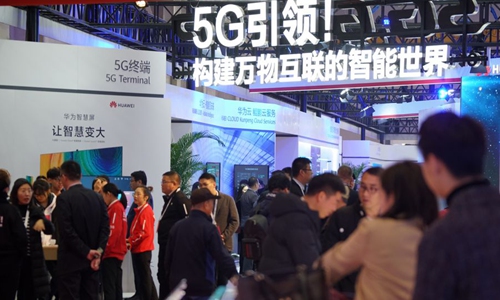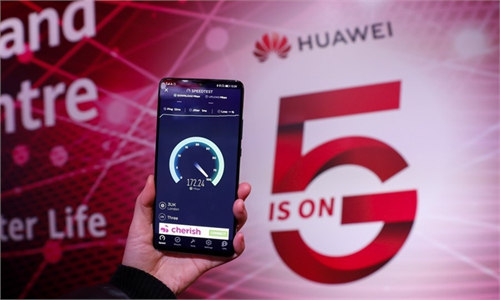SOURCE / INDUSTRIES
China rises to 5G leadership
Silver bullet elusive after first year of commercial service

Visitors look at the 5G intelligent system exhibition booth of China's Huawei at the 2019 World 5G Convention in Beijing, capital of China, Nov. 21, 2019. (Xinhua/Li Xin)
China, leading the world in 5G rollout and user base, is still looking for the silver bullet that will allow the new wireless technology to live up to consumer expectations, Chinese telecom analysts said on Sunday — marking the first anniversary of the nation's 5G commercialization.
During the past year, China has become the world's No.1 in 5G gear rollout, and some top-tier cities including Shenzhen and Beijing have achieved full 5G coverage.
The new technology was used at the Huoshenshan makeshift hospital in Wuhan, Central China's Hubei Province, to provide telemedicine service at the height of the country's battle to contain the coronavirus in February. It was also used for a live-streaming broadcast from the highest terrestrial 5G signal station at Mount Qomolangma, the world's highest peak.
Ge Qi, vice president of CloudMinds, a SoftBank-backed cloud robotics and artificial intelligence start-up, told the Global Times on Sunday that China is now leading the world in 5G. More than 690,000 5G base stations have been rolled out in China, with 160 million 5G subscribers, the most in the world, an official with the Ministry of Industry and Information Technology (MIIT) said on October 26.
"We have verified the feasibility of 5G technology and its resolutions, and the next step is propelling its implementation among enterprises and industries, which is the key role that the next-generation network should play," Ge added, noting that the vast consumer base in China is to boost confidence among consumers around the world.
By June, the country had worked more than 400 innovative 5G applications in areas including transportation and medical use, and more than 600 industrial projects that harness 5G technology.
Shipments of 5G-enabled phones accounted for 60 percent of the country's total smartphone shipments in September, according to the China Academy of Information and Communication Technology, a research institute under the MIIT.
However, there is also some disappointment concerning the technology's failed promise in everyday connection speeds and lack of super apps that could transform consumers' use of the ultrafast wireless technology. Some consumers are complaining that their 4G devices are running at a slower speed than before, possibly due to a shift in Chinese telecom carriers' investment focus to 5G.
Industry experts said one reason for the lagging expansion of industrial use is slowness of global technology community in drawing up related standards.
The lack of a silver bullet in 5G usage reflects society's high expectations for the new technology and the reality that the technology's development is still progressing, analysts said, and new telecom technology typically needs a few years to iron out unexpected issues.
Compared with the consumer segment, the 5G model for business is yet to commercialize, since it requires feasible technology resolution, workable ways for enterprises to save costs and enhance efficiency.
Ge believed that the next year will mark the initial step in China's march to wider business use of 5G. "It is challenging not only in China but around the world, since it is reliant on global resource allocation and cooperation," he added.
Delayed by the pandemic, the global telecom community just completed Release 16, a so-called second technical standard for 5G, via an industry body known as 3GPP in July. Release 16 will greatly boost 5G's potential in industrial use in 2021.
Domestic mobile carriers China Mobile, China Unicom and China Telecom, as well as telecom tower builder China Tower Corp, will invest a total of 200 billion yuan ($29.88 billion) on 5G this year.
Fu Liang, a Beijing-based telecom industry expert, told the Global Times that China owns scale advantage in massive 5G-compatible terminals, which hit the market at twice the volume as 4G terminals. These advantages will give 5G apps a chance to excel.
"Compared with the rollout of previous generations of wireless technology, China, for the first time, is trailed by other nations," Fu said. "But being first means you have to make some extra efforts to navigate uncharted waters."
More Chinese companies have moved toward intelligent factories harnessing 5G connection in synergy with AI and the Internet of Things.
Smartphone maker Xiaomi Corp announced in August that it is spending 600 million yuan to build a 5G-powered, fully automated factory that can churn out 10 million smartphones a year.
A 5G smart factory invested in by Inspur, China's largest server maker, has reduced the lead time to complete a customized order to five to seven days from 18 days previously, a newspaper affiliated with the MIIT reported in August.
Fu said that, building on China's current 5G strength, future highlights would include indoor wireless connections, deployment in rural areas and special venues such as the Olympics stadiums, while super apps may appear in 5G plus virtual reality scenarios.



